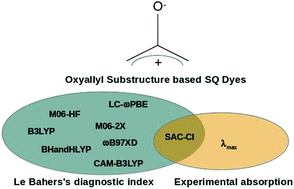Charge transfer or biradicaloid character: assessing TD-DFT and SAC-CI for squarylium dye derivatives†
Abstract
Keeping in view to suggest one more class of molecules in order to make a choice and assessment of exchange–correlation (XC) functionals, symmetrical squarylium dye (SQ) derivatives have been considered and Le Bahers's diagnostic indexes have been applied to study the electronic transition character of these molecular systems through TD-DFT and SAC-CI methods. Unlike calculated absorption using SAC-CI, the TD-DFT results do not match with experimental absorption data. However, the diagnostic indexes obtained with TD-DFT and SAC-CI are apparently similar for all methods. This indicates that care should be taken while choosing XC functionals and assessing the nature of electronic transitions of a specific class of molecules. The centroids of charges associated with the density increase and depletion regions are localized on the central C4 ring and carbonyl groups and with a small extension up to side aromatic substitution of the SQ dye derivative. Hence, the electronic transition occurring in this class of molecules is confined mainly within the central part of molecule. This is in contrast to donor–acceptor–donor type structure in which the charge depletion region is expected at side aromatic substitution of the molecule. The small values of calculated transferred charge (qCT) upon excitation lend support to the theory that the electronic transition in this class of molecules is not CT excitation. This is in agreement with our earlier finding that biradicaloid character and orbital interactions play a key role in their NIR absorption. Hence, highly correlated, single reference and a multi-determinant SAC-CI method is able to explain the nature of electronic excitations in these molecules rather than TD-DFT with various types of XC functionals.


 Please wait while we load your content...
Please wait while we load your content...